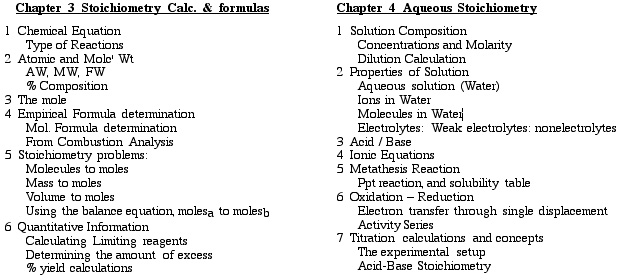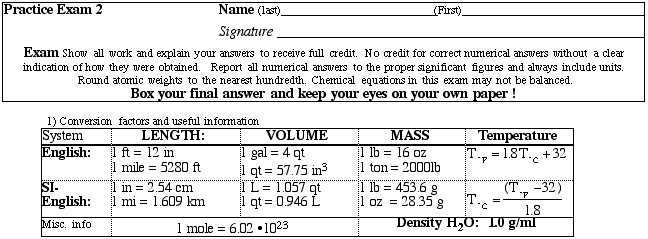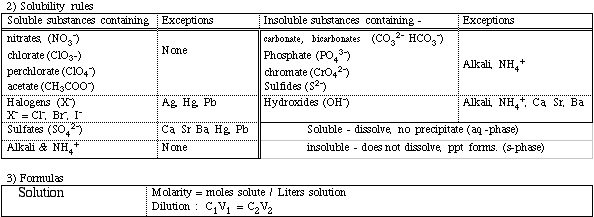Practice Exam 2 Stoichiometry Calculations and Aqueous Systems




Periodic Table
1
Combustion of a sulfide of bismuth compound, BixSy (50.00g) in O2 produced 45.30 g of dibismuth trioxide (Bi2O3).
i) What is the compound name, empirical formula and the formula weight of the bismuth sulfide (BixSy) compound?
ii) What is the oxidation state of the sulfur and the bismuth in this compound?
iii) Suppose in your combustion experiment, the BixSy compound also contained some bismuth oxide impurities, how would this affect the x-value in the empirical formula of BixSy (higher or lower and state your reason)?
iv) Suppose instead of producing 45.30 g dibismuth trioxide in the final product of the combustion, 45.30 g of dibismuth pentaoxide is produced instead, how would this affect the y-value in the empirical formula of BixSy ?
2
.Balance the following equations (if the equations are are written as chemical names, first translate it to formulas). Identify the type of reaction above.
i) ___KOH(aq) + ___H2SO4(aq) ___ K2SO4 (aq) + ___H2O (aq)
ii) ___C4H14(l) + ____O2(g) ___CO2(g) + ____ H2O(l)
iii) ___N2H4(l) + ___O2(g) ___ NO2 (g) + ___ H2O (g)
iv) ___K2CO3 (aq) + ___H3PO4(aq) ___ K3PO4 (aq) + ___CO2(g) + ____ H2O(l)
v) Arsenic(III) oxide + Hydrochloric acid Arsenic(III) chloride + Dihydrogen monoxide
vi) Phosphorus + Bromine Phosphorus tribromide
vii) Calcium carbonate decomposes to cacium oxide and carbon dioxide viii) Copper(II) sulfate pentahydrate is dehydrated to ______ + ______
3
A compound of Ca, C, N, and S was subjected to quantitative analysis and formula mass determination, and the following data were obtained. A 0.250 g sample was mixed with Na2CO3 to convert all of the Ca to 0.160 g of CaCO3. A 0.0268 g sample of the compound was carried through a series of reactions until all of the S was changed to 0.0802 g of BaSO4. A 0.712g sample was processed to liberate all of its N as NH3, and 0.155 g NH3 was obtained. The formula mass was found to be 156 g/mol. Determine the empirical and molecular formulas of this compound.
4
2,4,6-Trinitrotoluene (TNT), C7H5N3O6 , can be prepared by the following two step synthesis:
C6H6 + CH4C7H8 + H2
2 C7H8 + 6 NO22 C7H5N3O6 + 3 H2
If each step in this synthesis gives a 50% yield, how much C7H5N3O6 (TNT) in grams can be produced starting with 780 g of benzene (C6H6) ?
5
Ethyl alcohol (booze), C2H5OH, also called grain alcohol, can be made by the fermentation of glucose, C6H12O6, which often comes from starch in grain:
___ C6H12O6(aq)___ C2H5OH(l) + ___ CO2(g)
Determine the maximum mass (theoretical yield) of ethyl alcohol which could be produced from 750 g of glucose. If 150. L of CO2 is collected after the fermentation, what is the % yield. Density of CO2 (g)is 1.96 g/ L
6
Determine which of the following will dissolve in water, then classify these as
(s) strong electrolyte, (w) weak electrolyte or (n) non-electrolyte.Explain your answer.
i) NH3 ii) PbSO4 iii) KHSO4 iv) Hg2Cl2 v) HNO3 vi) NH4OH vii) C2H5OH
7
Write the net ionic equation for any reaction that occurs upon mixing each pair of solution:
i) silver nitrate and barium chloride ii) Magnesium sulfate and barium hydroxide iii) Hydrochloric acid and strontium hydroxide. iv) Iron(III) sulfide and nitric acid
8
In each of the following reaction, indicate which metal ion is the stronger oxidizing agent, that is rank each metal Zn, Ag and Pb in order of difficulet of oxidation . (i.e., Most easily oxidized > next easily oxidize > most difficult to oxidize)
i) Zn (s) + 2AgNO3(aq) 2 Ag (s) + Zn(NO3)2(aq)
ii) Pb (s) + 2AgNO3 (aq) 2 Ag (s) + Pb(NO3)2(aq)
iii) Pb (s) + Zn(NO3)2 (aq) NR.
9
Some sulfuric acid is spilled on a lab bench. It can be neutralized by sprinkling some sodium bicarbonate on to the sulfuric acid. The reaction produces sodium sulfate, carbon dioxide and water.
i) Write the molecular, ionic and net ionic equation and balance the equation (include the phases). ii) What is the limiting reagent and how much remains if 35 ml of 6.0 M sulfuric acid is spilled and 50 grams of sodium bicarbonate is added ? iii) What is the mass of carbon dioxide gas (in grams) that is produced ? iv) How many molecules of carbon dioxide is produced ? v) If 5.00 ml of water is actually produce, what is the % yield of water ? vi) How many oxygen atoms are involved in this reaction ? vii) If all the liquid is evaporated, what is the mass of sodium sulfate that is produced ? viii) What is the concentration of sodium sulfate if 20.0 g sodium sulfate is dissolved in the 5.00 ml water? ix) Suppose potassium hydroxide is substituted for sodium bicarbonate in the above reaction. What mass of potassium hydroxide is required to neutralize 35 ml of 6.0 M sulfuric acid.
10
Balance the following equations and then answer the questions below.
Potassium permanganate is added to hydrochloric acid to produce
chlorine gas, potassium chloride, manganese(II) chloride and water.
i) How many moles of hydrochloric acid are required to react with 45 grams of potassium permanganate ? ii) How many chlorine moleucles will be produced using 5.0 moles of potassium permanganate ? iii) To produce 55.0 grams of manganese(II) chloride, what mass of hydrochloric acid is required? iv) How many moles of water will be produce when 7.00 moles of potassium permanganate is consumed ? v) What is the maximum weight of chlorine that can be produced by reacting 35.0 g of potassium permanganate with 45.0 g of hydrochloric acid ?` vi) In v (above), if the %yield of chlorine in the reaction is 76%, how much (g) chlorine was acutally recovered ?